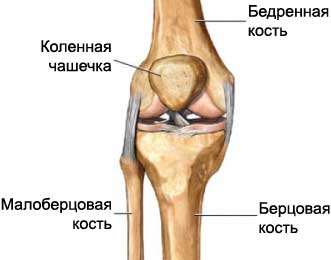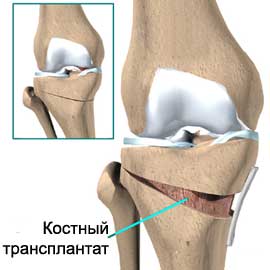Osteotomy of the knee – Osteotomy of the knee joint
Description Knee osteotomy
Osteotomy of the knee – removal of bone to the shin bone wedge, providing greater knee range of motion and pain relief.

Causes of knee osteotomy
Procedure changes the knee so, that most of the weight transferred to the healthy part of the knee, that offloads the damaged part. Damage often arises due osteoarthritis. This operation can be done instead of a full knee replacement.
Knee osteotomy does not cure the disease, as osteoarthritis, but the operation may:
- Relieve pain;
- Improve range of motion;
- Delay further damage to the joint;
- Postpone operation knee replacement.
Possible complications of a knee osteotomy
Complications are rare, but no procedure does not guarantee the absence of risk. If you plan to osteotomy of the knee joint, you need to know about possible complications, which may include:
- Bleeding;
- Reaction to anesthesia;
- Infection;
- Blood clots;
- Nausea and vomiting;
- Injury of nerves and blood vessels;
- Reducing the length of the legs;
Factors, that may increase the risk of complications:
- Smoking
We need to discuss these risks with your doctor.
How is the knee osteotomy?
Preparation for the procedure
Before surgery, the doctor will prescribe tests, to confirm the diagnosis and determine the, how much bone needs to be removed. Tests may include:
- X-ray examination;
- MRT – It uses magnetic waves, to make pictures of structures inside the body;
- CT (CT scan) – such as X-rays, which uses computer, to make pictures of structures inside the body.
In just a few days before surgery:
- Talk to your doctor about taking any medications. You may be asked to stop taking certain medicines a week before the procedure,, eg, anti-inflammatory drugs and blood thinners.
- Do not eat or drink anything the night before surgery.
Anesthesia
They can be used the following types of anesthesia:
- General anesthesia – blocks any pain and the patient support in a sleep state during operation. Administered intravenously in the arm or hand.
- Spinalynaya or эpiduralynaya anesthesia – blocks pain in the lower body, from the chest down, the patient is awake. Was injected in the back.
Procedure osteotomy of the knee joint
There are many methods, which can be used to perform knee osteotomy.
In one method, the doctor uses the image processing for measurement of the bone, to be deleted. Running skin incision from the patella to the top of the tibia. Several thin wires are placed in the knee joint, to serve as reference points, showing, any bone to be removed. The doctor uses a chainsaw, to remove the bone wedge. The remaining part of the bone compared and held together staples, ştiftami, or plates with screws. After the procedure, the doctor sews up the incision with stitches.

Immediately after knee osteotomy
You will be in the recovery room for several hours. The hospital staff will monitor vital signs. You may be given pain medicine.
How long will the osteotomy of the knee joint?
Duration of operation 1-3 o'clock.
Osteotomy of the knee joint – Will it hurt?
Anesthesia prevents pain during surgery. After the operation the doctor prescribes pain medicine .
The average hospital stay after knee osteotomy
Maybe, you have to stay in the hospital 2-3 day. The doctor can extend the period of stay, If there are complications.
Care after osteotomy of the knee joint
Care in a hospital
During the restoration of the hospital:
- The staff will give you pain medicine;
- In place of the cut applied soft patch;
- Prikladyvajte ice, to reduce swelling of the surgical site;
- It is necessary to move the leg, to improve circulation and reduce the risk of blood clots. Also, for these purposes, the device can be used Continuous Passive Mobilization (NPM), if the bone has been fixed by means of plates and screws. He alone moves the knee joint along a predetermined path.
- We need to breathe deeply and cough 10-20 times each hour, to reduce the risk of lung infection.
You will also need to use crutches or a walker.
Home Care
When you return home, Follow these steps:, to ensure the normal recovery:
- Take the use of analgesics;
- Apply ice or a cold compress on the area of operation during the 15-20 minutes four times a day. Wrap the ice in a towel, Do not place it directly on the skin;
- Raise the injured leg, to reduce swelling;
- If you have a cast, Follow your doctor's instructions for skin care;
- Use crutches or a walker. Do not carry the weight on the injured leg, until the doctor gives permission;
- Keep the incision site clean and dry.
- Ask the doctor, when it is safe to shower, bathe, or to expose the surgical site to water;
- Through 6-8 weeks to start working with a physical therapist. The therapy will focus on the balance sheet, expanding the range of motion and strength training;
- Follow your doctor's instructions.
You will need to go back to the doctor, to remove plaster or x-rays of the joint. Full recovery can take six months.
Contact your doctor after osteotomy of the knee
After discharge from the hospital need to see a doctor, If the following symptoms:
- Signs of infection (eg, fever, chills);
- Redness, edema, increased pain, bleeding, or discharge from the incision;
- Increased pain or swelling;
- Cough, breathlessness, chest pain;
- Severe nausea and vomiting;
- Numbness, tingling or loss of sensation in the foot, knees or stupas;
- Edema, fever or pain in the lower leg;
- Pain, burning, frequent urination, blood in urine.
